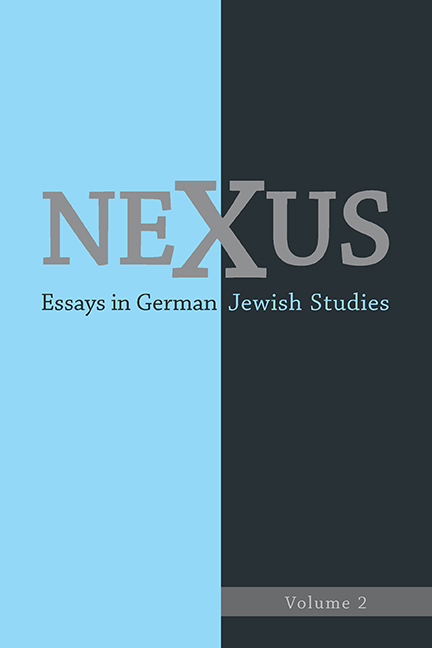Book contents
- Frontmatter
- Dedication
- Contents
- Acknowledgments
- Introduction
- Nexus Forum
- Introduction to the Nexus Forum A Most Unwanted Man: Hans-Joachim Schoeps
- Jew, Prussian, German: The Adventuresome Story of Hans-Joachim Schoeps
- Hans-Joachim Schoeps: Contrarian Scholar
- The Meyerowitz Family from Königsberg: Contemporaries of Hans-Joachim Schoeps
- From the Margins: A Response to Schoeps on Schoeps
- A Conservative Christian Welcome: A Response to Julius Schoeps
- Facing His Nazi Past? A Response to Schoeps on Schoeps
- Setting the Record Straight Regarding The Protocols of the Elders of Zion: A Fool's Errand?
- A Discussion of the “German” Dimension of Reform Judaism in Select Congregations in Three American Southern States, 1860–1880
- Weimar on Broadway: Fritz Kortner and Dorothy Thompson's Refugee Play Another Sun
- If I forget thee, O Jerusalem: The Jewish Exilic Mind in Else Lasker-Schüler's IchundIch
- “Seit ein Gespräch wir sind und hören können von einander”: Martin Buber's Message to Postwar Germany
- Hungerkünstler: George Tabori Directs Kafka in Bremen (1977)
A Discussion of the “German” Dimension of Reform Judaism in Select Congregations in Three American Southern States, 1860–1880
from Nexus Forum
Published online by Cambridge University Press: 15 March 2018
- Frontmatter
- Dedication
- Contents
- Acknowledgments
- Introduction
- Nexus Forum
- Introduction to the Nexus Forum A Most Unwanted Man: Hans-Joachim Schoeps
- Jew, Prussian, German: The Adventuresome Story of Hans-Joachim Schoeps
- Hans-Joachim Schoeps: Contrarian Scholar
- The Meyerowitz Family from Königsberg: Contemporaries of Hans-Joachim Schoeps
- From the Margins: A Response to Schoeps on Schoeps
- A Conservative Christian Welcome: A Response to Julius Schoeps
- Facing His Nazi Past? A Response to Schoeps on Schoeps
- Setting the Record Straight Regarding The Protocols of the Elders of Zion: A Fool's Errand?
- A Discussion of the “German” Dimension of Reform Judaism in Select Congregations in Three American Southern States, 1860–1880
- Weimar on Broadway: Fritz Kortner and Dorothy Thompson's Refugee Play Another Sun
- If I forget thee, O Jerusalem: The Jewish Exilic Mind in Else Lasker-Schüler's IchundIch
- “Seit ein Gespräch wir sind und hören können von einander”: Martin Buber's Message to Postwar Germany
- Hungerkünstler: George Tabori Directs Kafka in Bremen (1977)
Summary
The two decades encompassing the Civil War and Reconstruction (1860–80) saw the establishment of many Jewish congregations and the development of Reform Judaism in the United States. The period also saw the climax of the so-called “German period” of American Jewry. This, and the fact that prominent Reformers like David Einhorn and Samuel Hirsch were Germans to the core, suggest a connection between nascent American Reform Judaism and its German counterpart. It is too simplistic, though, to see American Reform as a mere transplant of German Reform. Using Jewish congregations of the period in Georgia and North and South Carolina as examples of the Reform process in regions of the United States distinct from major metropolitan areas like New York, Philadelphia, Baltimore, and Cincinnati, this essay analyzes German aspects of American Reform Judaism, focusing on the demographic composition of communities (i.e., the entirety of Jewish residents in one town), membership of congregations (i.e., organized religious bodies), religious concepts, and rabbis of German origin. The essay argues that in these southern states, the need to adapt to American realities and the urge and pressure to Americanize were more crucial for the process than were German influences. In this region the Reform movement, while possibly inspired by German ideas, was an American development that arose from American needs and convictions.
Introduction
THE MID-NINETEENTH CENTURY was a formative period for Jewish organized religion for many communities in the United States. In accordance with Jacob Rader Marcus's description of a “German wave” of Jewish immigration to the United States for the better part of the nineteenth century, that is, up until the mass migration of East Europeans from 1880 onward, it would seem that the Reform process was inseparably connected with contemporaneous developments in Germany. According to Jonathan Sarna, at the point when the Reform movement was finally consolidated in the Pittsburgh Platform of 1885, it had “positioned itself as the religion of American Jews of German-descent.” Norbert Max Samuelson has suggested that the Reform movement was the outcome of transplanted ideas from Germany brought over the Atlantic by reformers who sought to accomplish in America what the German states had thwarted in Europe. And, indeed, German-born radical Reformers like David Einhorn and Samuel Hirsch, and especially the moderate Isaac Mayer Wise, dominated the early phase of Reform Judaism in the United States.
- Type
- Chapter
- Information
- NexusEssays in German Jewish Studies, pp. 63 - 80Publisher: Boydell & BrewerPrint publication year: 2013



